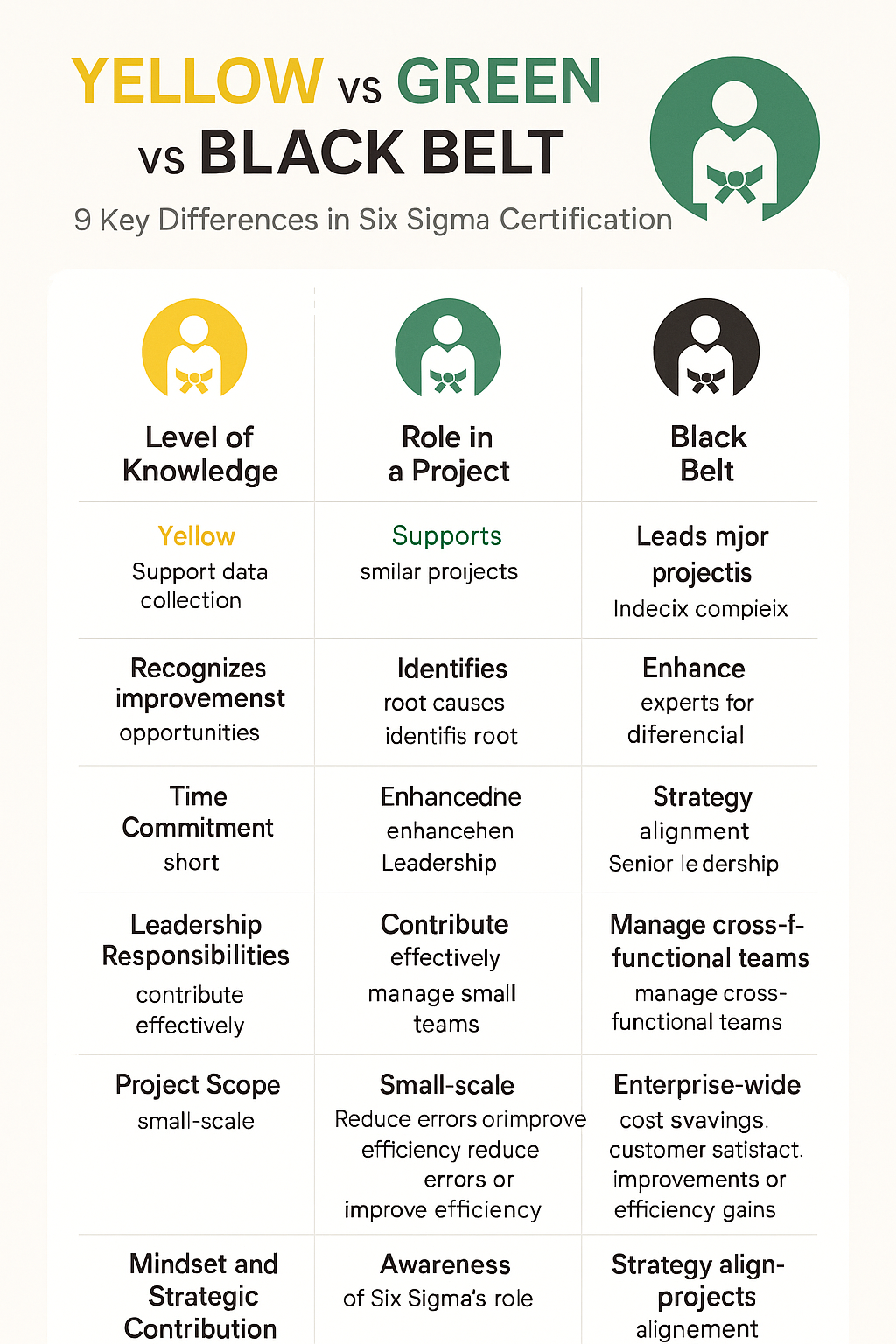The first major difference lies in the level of knowledge. Yellow Belt introduces the fundamentals, teaching the basic terminology and principles of Six Sigma so professionals can understand how process improvement contributes to organizational goals. Green Belt goes further, providing in-depth knowledge of tools such as root cause analysis and process mapping, along with an introduction to statistical methods. At the highest of these three levels, Black Belt develops mastery in advanced tools such as regression analysis, design of experiments, and complex data interpretation, preparing professionals to handle sophisticated projects.
Another distinction is the role in projects. Yellow Belts usually serve as supportive team members, contributing data and ideas under the guidance of more experienced practitioners. Green Belts step into leadership of smaller projects and assist with larger initiatives led by Black Belts. Black Belts, however, assume the role of primary project leaders, managing teams, setting direction, and ensuring projects align with business strategy.
Closely related is the expectation for problem-solving. Yellow Belts are tasked with recognizing opportunities for improvement and applying simple solutions. Green Belts are expected to diagnose problems, identify root causes, and implement validated fixes. Black Belts go beyond this, creating strategies for large-scale change and ensuring solutions drive long-term business impact.
The use of statistical tools also differentiates the belts. Yellow Belts rely on straightforward quality tools such as basic charts. Green Belts employ more advanced techniques, including control charts, Pareto analysis, and hypothesis testing. Black Belts make use of highly sophisticated statistical approaches, often working with specialized software to conduct experiments and predictive modeling.
Time commitment varies significantly across the levels. Yellow Belt training can usually be completed quickly, making it ideal for beginners or those with limited availability. Green Belt training requires more time and effort, often including the completion of one or more projects. Black Belt training is the most demanding, involving extensive study, practical application, and leadership of significant organizational projects.
The impact on career also grows with each belt. Earning a Yellow Belt enhances credibility by showing an understanding of basic principles, while Green Belt certification can open opportunities for mid-level management and project leadership. Black Belt certification is often associated with senior leadership roles, consulting positions, and specialized improvement-focused careers.
Leadership responsibility is another area of difference. Yellow Belts are not expected to lead but to contribute effectively within teams. Green Belts often manage small project teams and lead departmental initiatives. Black Belts, however, carry the responsibility of managing cross-functional teams and mentoring professionals at lower belt levels.
The scope of projects expands as well. Yellow Belt projects are usually localized and focus on small-scale improvements within a department. Green Belt projects typically address medium-scale issues such as reducing errors or improving efficiency across workflows. Black Belt projects span enterprise-wide challenges and are often tied directly to cost savings, customer satisfaction, and strategic performance improvements.
Finally, the mindset and strategic contribution of each belt reflects its level. Yellow Belts build awareness of Six Sigma's role within their organization. Green Belts balance tactical problem-solving with measurable business outcomes. Black Belts operate at the strategic level, aligning process improvement initiatives with organizational goals and influencing leadership decisions.
Together, these nine differences illustrate how the Six Sigma belt system provides a clear progression of skills, responsibilities, and career opportunities. Whether you begin with a Yellow Belt to gain awareness, pursue a Green Belt to lead projects, or commit to a Black Belt for enterprise-level leadership, each step builds upon the last and contributes to long-term professional growth.
Another distinction is the role in projects. Yellow Belts usually serve as supportive team members, contributing data and ideas under the guidance of more experienced practitioners. Green Belts step into leadership of smaller projects and assist with larger initiatives led by Black Belts. Black Belts, however, assume the role of primary project leaders, managing teams, setting direction, and ensuring projects align with business strategy.
Closely related is the expectation for problem-solving. Yellow Belts are tasked with recognizing opportunities for improvement and applying simple solutions. Green Belts are expected to diagnose problems, identify root causes, and implement validated fixes. Black Belts go beyond this, creating strategies for large-scale change and ensuring solutions drive long-term business impact.
The use of statistical tools also differentiates the belts. Yellow Belts rely on straightforward quality tools such as basic charts. Green Belts employ more advanced techniques, including control charts, Pareto analysis, and hypothesis testing. Black Belts make use of highly sophisticated statistical approaches, often working with specialized software to conduct experiments and predictive modeling.
Time commitment varies significantly across the levels. Yellow Belt training can usually be completed quickly, making it ideal for beginners or those with limited availability. Green Belt training requires more time and effort, often including the completion of one or more projects. Black Belt training is the most demanding, involving extensive study, practical application, and leadership of significant organizational projects.
The impact on career also grows with each belt. Earning a Yellow Belt enhances credibility by showing an understanding of basic principles, while Green Belt certification can open opportunities for mid-level management and project leadership. Black Belt certification is often associated with senior leadership roles, consulting positions, and specialized improvement-focused careers.
Leadership responsibility is another area of difference. Yellow Belts are not expected to lead but to contribute effectively within teams. Green Belts often manage small project teams and lead departmental initiatives. Black Belts, however, carry the responsibility of managing cross-functional teams and mentoring professionals at lower belt levels.
The scope of projects expands as well. Yellow Belt projects are usually localized and focus on small-scale improvements within a department. Green Belt projects typically address medium-scale issues such as reducing errors or improving efficiency across workflows. Black Belt projects span enterprise-wide challenges and are often tied directly to cost savings, customer satisfaction, and strategic performance improvements.
Finally, the mindset and strategic contribution of each belt reflects its level. Yellow Belts build awareness of Six Sigma's role within their organization. Green Belts balance tactical problem-solving with measurable business outcomes. Black Belts operate at the strategic level, aligning process improvement initiatives with organizational goals and influencing leadership decisions.
Together, these nine differences illustrate how the Six Sigma belt system provides a clear progression of skills, responsibilities, and career opportunities. Whether you begin with a Yellow Belt to gain awareness, pursue a Green Belt to lead projects, or commit to a Black Belt for enterprise-level leadership, each step builds upon the last and contributes to long-term professional growth.


